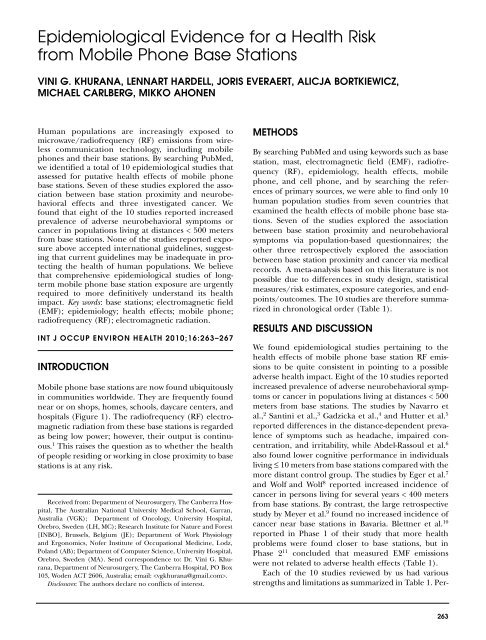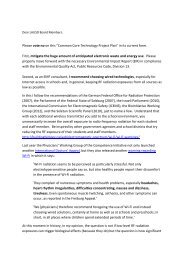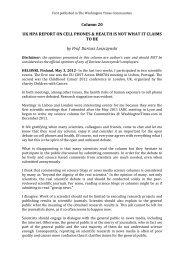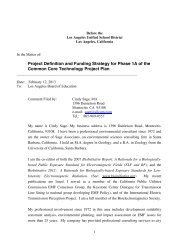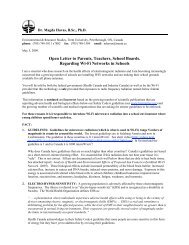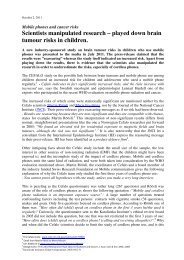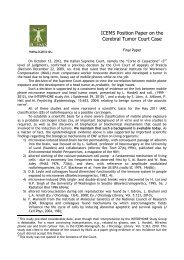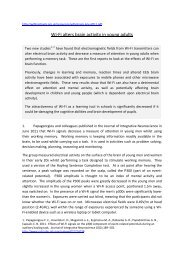Epidemiological Evidence for a Health Risk from Mobile Phone ...
Epidemiological Evidence for a Health Risk from Mobile Phone ...
Epidemiological Evidence for a Health Risk from Mobile Phone ...
Create successful ePaper yourself
Turn your PDF publications into a flip-book with our unique Google optimized e-Paper software.
<strong>Epidemiological</strong> <strong>Evidence</strong> <strong>for</strong> a <strong>Health</strong> <strong>Risk</strong><br />
<strong>from</strong> <strong>Mobile</strong> <strong>Phone</strong> Base Stations<br />
VINI G. KHURANA, LENNART HARDELL, JORIS EVERAERT, ALICJA BORTKIEWICZ,<br />
MICHAEL CARLBERG, MIKKO AHONEN<br />
Human populations are increasingly exposed to<br />
microwave/radiofrequency (RF) emissions <strong>from</strong> wireless<br />
communication technology, including mobile<br />
phones and their base stations. By searching PubMed,<br />
we identified a total of 10 epidemiological studies that<br />
assessed <strong>for</strong> putative health effects of mobile phone<br />
base stations. Seven of these studies explored the association<br />
between base station proximity and neurobehavioral<br />
effects and three investigated cancer. We<br />
found that eight of the 10 studies reported increased<br />
prevalence of adverse neurobehavioral symptoms or<br />
cancer in populations living at distances < 500 meters<br />
<strong>from</strong> base stations. None of the studies reported exposure<br />
above accepted international guidelines, suggesting<br />
that current guidelines may be inadequate in protecting<br />
the health of human populations. We believe<br />
that comprehensive epidemiological studies of longterm<br />
mobile phone base station exposure are urgently<br />
required to more definitively understand its health<br />
impact. Key words: base stations; electromagnetic field<br />
(EMF); epidemiology; health effects; mobile phone;<br />
radiofrequency (RF); electromagnetic radiation.<br />
INT J OCCUP ENVIRON HEALTH 2010;16:263–267<br />
INTRODUCTION<br />
<strong>Mobile</strong> phone base stations are now found ubiquitously<br />
in communities worldwide. They are frequently found<br />
near or on shops, homes, schools, daycare centers, and<br />
hospitals (Figure 1). The radiofrequency (RF) electromagnetic<br />
radiation <strong>from</strong> these base stations is regarded<br />
as being low power; however, their output is continuous.<br />
1 This raises the question as to whether the health<br />
of people residing or working in close proximity to base<br />
stations is at any risk.<br />
Received <strong>from</strong>: Department of Neurosurgery, The Canberra Hospital,<br />
The Australian National University Medical School, Garran,<br />
Australia (VGK); Department of Oncology, University Hospital,<br />
Orebro, Sweden (LH, MC); Research Institute <strong>for</strong> Nature and Forest<br />
[INBO], Brussels, Belgium (JE); Department of Work Physiology<br />
and Ergonomics, Nofer Institute of Occupational Medicine, Lodz,<br />
Poland (AB); Department of Computer Science, University Hospital,<br />
Orebro, Sweden (MA). Send correspondence to: Dr. Vini G. Khurana,<br />
Department of Neurosurgery, The Canberra Hospital, PO Box<br />
103, Woden ACT 2606, Australia; email: .<br />
Disclosures: The authors declare no conflicts of interest.<br />
METHODS<br />
By searching PubMed and using keywords such as base<br />
station, mast, electromagnetic field (EMF), radiofrequency<br />
(RF), epidemiology, health effects, mobile<br />
phone, and cell phone, and by searching the references<br />
of primary sources, we were able to find only 10<br />
human population studies <strong>from</strong> seven countries that<br />
examined the health effects of mobile phone base stations.<br />
Seven of the studies explored the association<br />
between base station proximity and neurobehavioral<br />
symptoms via population-based questionnaires; the<br />
other three retrospectively explored the association<br />
between base station proximity and cancer via medical<br />
records. A meta-analysis based on this literature is not<br />
possible due to differences in study design, statistical<br />
measures/risk estimates, exposure categories, and endpoints/outcomes.<br />
The 10 studies are there<strong>for</strong>e summarized<br />
in chronological order (Table 1).<br />
RESULTS AND DISCUSSION<br />
We found epidemiological studies pertaining to the<br />
health effects of mobile phone base station RF emissions<br />
to be quite consistent in pointing to a possible<br />
adverse health impact. Eight of the 10 studies reported<br />
increased prevalence of adverse neurobehavioral symptoms<br />
or cancer in populations living at distances < 500<br />
meters <strong>from</strong> base stations. The studies by Navarro et<br />
al., 2 Santini et al., 3 Gadzicka et al., 4 and Hutter et al. 5<br />
reported differences in the distance-dependent prevalence<br />
of symptoms such as headache, impaired concentration,<br />
and irritability, while Abdel-Rassoul et al. 6<br />
also found lower cognitive per<strong>for</strong>mance in individuals<br />
living ≤ 10 meters <strong>from</strong> base stations compared with the<br />
more distant control group. The studies by Eger et al. 7<br />
and Wolf and Wolf 8 reported increased incidence of<br />
cancer in persons living <strong>for</strong> several years < 400 meters<br />
<strong>from</strong> base stations. By contrast, the large retrospective<br />
study by Meyer et al. 9 found no increased incidence of<br />
cancer near base stations in Bavaria. Blettner et al. 10<br />
reported in Phase 1 of their study that more health<br />
problems were found closer to base stations, but in<br />
Phase 2 11 concluded that measured EMF emissions<br />
were not related to adverse health effects (Table 1).<br />
Each of the 10 studies reviewed by us had various<br />
strengths and limitations as summarized in Table 1. Per-<br />
263
Figure 1—<strong>Mobile</strong> phone base stations ("antennae" or "masts") in Australia. Upper left: Community shop roof showing<br />
plethora of flat panel antennae. Upper right: Hospital roof with flat panel antennae painted to blend in. Lower left:<br />
Top of a street light pole. Lower center: Mast erected next to a daycare center. Lower right: Antennae mounted on<br />
an office block top floor.<br />
taining to those base station studies in which EMF measurements<br />
were not carried out, 3,4,7,9 it should be noted<br />
that distance is not the most suitable classifier <strong>for</strong> exposure<br />
to RF-EMF. Antennae numbers and configurations,<br />
as well as the absorption and reflection of their fields by<br />
houses, trees, or other geographic hindrances may<br />
influence the exposure level. Further, self-estimation of<br />
distance to nearest base station is not the best predictor<br />
of exposure since the location of the closest base station<br />
is not always known. Such exposure misclassification<br />
inevitably biases any association towards null. Multiple<br />
testing might also produce spurious results if not<br />
adjusted <strong>for</strong>, 3,5 as might failure to adjust <strong>for</strong> participant<br />
age and gender. 7 Latency is also an important consideration<br />
in the context of cancer incidence following or<br />
during a putative environmental exposure. In this<br />
regard, the study by Meyer et al. 9 found no association<br />
between mobile phone base station exposure and<br />
cancer incidence, but had a relatively limited observation<br />
period of only two years. On the other hand, the<br />
studies by Eger et al. 7 and Wolf and Wolf 8 found a significant<br />
association between mobile phone base station<br />
exposure and increased cancer incidence, although the<br />
approximate five-year latency between base station<br />
exposure and cancer diagnosis appears to be unexpectedly<br />
short in both of these studies.<br />
Other problems in several population-based questionnaires<br />
are the potential <strong>for</strong> bias, especially selection 8<br />
and participation 2,3,5,6,11 biases, and self-reporting of<br />
outcomes in combination with the exposure assessment<br />
methods used. For example, regarding limitations in<br />
exposure assessment, in a large two-phase base station<br />
study <strong>from</strong> Germany, 12,13 of the Phase 1 participants (n =<br />
30,047), only 1326 (4.4%) participated with a single<br />
“spot” EMF measurement recorded in the bedroom <strong>for</strong><br />
Phase 2. Further, health effect contributions <strong>from</strong> all<br />
relevant EMF sources and other non-EMF environmental<br />
sources need to be taken into account. 12 We acknowledge<br />
that participant concern instead of exposure<br />
could be the triggering factor of adverse health effects,<br />
however this “nocebo effect” does not appear to fully<br />
explain the findings. 4,5 Further, the biological relevance<br />
of the overall adverse findings (Table 1) is supported by<br />
the fact that some of the symptoms in these base-station<br />
studies have also been reported among mobile phone<br />
users, such as headaches, concentration difficulties, and<br />
sleep disorders. 13,14 Finally, none of the studies that<br />
found adverse health effects of base stations reported<br />
RF exposures above accepted international guidelines,<br />
the implication being that if such findings continue to<br />
be reproduced, current exposure standards are inadequate<br />
in protecting human populations. 15<br />
264 • Khurana et al. www.ijoeh.com • INT J OCCUP ENVIRON HEALTH
TABLE 1 Summary of <strong>Epidemiological</strong> Studies of <strong>Mobile</strong> <strong>Phone</strong> Base Station <strong>Health</strong> Effects<br />
Base<br />
Publication Clinical Study Station EMF<br />
(Year; Country) Assessment Design Details Participants Measured Key Findings Strengths Limitations<br />
Navarro2 Neuro- Survey- GSM-DCS 101 Yes More symptoms with Detailed questionnaire, Low participation, self-<br />
(2003; Spain) behavioral questionnaire 1800 MHz closer proximity to base EMF measured, distan- estimated distances,<br />
station (< 150 m) ces studieda subjects awareb Santini2 Neuro- Survey- n/s 530 No More symptoms with Detailed questionnaire, As above, plus no EMF<br />
(2003; France) behavioral questionnaire closer proximity to base distances & other EMF measurements, no base<br />
station (< 300 m) exposures assessed station details<br />
Eger7 Cancer Retrospective GSM 967 No 3 x risk of cancer after Maximum beam Other environmental risk<br />
(2004; incidence case review 935 MHz 5 yrs of exposure intensity calculated, factors not assessed;<br />
Germany) (< 400 m); early age reliable cancer data analysis not adjusted <strong>for</strong><br />
of cancer diagnosis collection age and sex.<br />
Wolf & Wolf8 Cancer Retrospective TDMA 1844 Yes > 4 x risk of cancer Reliable cancer & dem- Not all environmental risk<br />
(2004; Israel) incidence case review 850 MHz after 3–7 yrs exposure ographic data, no other factors assessed; possible<br />
(< 350 m); early age major environmental selection bias; no age,<br />
of cancer diagnosis pollutant identified sex adjustment.<br />
Gadzicka4 Neuro- Survey- n/s 500 No More headache with Detailed questionnaire, Subjects aware, no base<br />
(2006; Poland) behavioral questionnaire proximity < 150 m; distances & EMF studied, station details<br />
nocebo unlikelyc nocebo studied<br />
Hutter5 Neuro- Cross- 900 MHz 336 Yes Headaches & impaired Detailed questionnaire Subjects aware, low<br />
(2006; Austria) behavioral sectional concentration at higher and testing, EMF mea- participation rate<br />
power density; nocebo sured, distances studied;<br />
unlikely nocebo effect studied<br />
Meyer9 Cancer Retrospective n/s 177,428 No No increased cancer Wide population Observation period only 2<br />
(2006; incidence case review incidence in municipal- assessed (Bavaria) years, vague definitions of<br />
Germany) ities with or without exposure, exposure onset<br />
base stations unknown, distance to base<br />
station unknown<br />
Abdel-Rassoul6 Neuro- Cross- n/s 165 Yes More symptoms & lower Detailed questionnaire Exact base station details<br />
(2007; Egypt) behavioral sectional cognitive per<strong>for</strong>mance and testing, EMF mea- n/s, low number of<br />
if living under or < 10 m sured, distances studied, participants<br />
<strong>from</strong> base station subjects unaware<br />
Blettner10 Neuro- Cross- n/s 30,047 No More health complaints Wide population EMF measurements not car-<br />
(2009; behavioral sectional closer to base station assessed, detailed survey, ried out (see phase II in Berg-<br />
Germany) (< 500 m) nocebo effect assessed Beckhoff et al., 2009; below)<br />
Berg-Beckhoff11 Neuro- Cross- GSM 900 MHz 1326 Yes <strong>Health</strong> effects probably Measured EMF emissions, Low participation, no<br />
(2009; behavioral sectional GSM 1800 MHz caused by stress and not standardized detailed list of symptoms<br />
Germany) UMTS 1920–1980 by RF-EMF questionnaires published, single “spot” mea-<br />
MHz surement in one place in<br />
dwelling, no occupational<br />
exposure assessed, time lag<br />
<strong>from</strong> assessment of symptoms<br />
and EMF measurement<br />
n / s = not specified.<br />
a “Distance” refers to distance between base station and subjects’ households.<br />
b “Subjects aware” refers to study participants being aware of the nature of the study.<br />
c “Nocebo” effect unlikely because the majority of subjects in the study reported little or no concern <strong>for</strong> base station proximity.<br />
VOL 16/NO 3, JUL/SEP 2010 • www.ijoeh.com <strong>Health</strong> <strong>Risk</strong>s <strong>from</strong> <strong>Mobile</strong> <strong>Phone</strong> Base Stations • 265
CONCLUSIONS<br />
Despite variations in the design, size and quality of<br />
these studies as summarized in Table 1, it is the consistency<br />
of the base-station epidemiological literature<br />
<strong>from</strong> several countries that we find striking. In<br />
particular, the increased prevalence of adverse neurobehavioral<br />
symptoms or cancer in populations<br />
living at distances < 500 meters <strong>from</strong> base stations<br />
found in 80% of the available studies. It should be<br />
pointed out that the overall findings of health problems<br />
associated with base stations might be based on<br />
methodological weaknesses, especially since exposure<br />
to RF electromagnetic radiation was not always<br />
measured.<br />
There are some proposed mechanisms via which<br />
low-intensity EMF might affect animal and human<br />
health, 16,17 but full comprehensive mechanisms still<br />
remain to be determined. 18,19 Despite this, the accumulating<br />
epidemiological literature pertaining to the<br />
health effects of mobile phones 13,20 and their base stations<br />
(Table 1) suggests that previous exposure standards<br />
based on the thermal effects of EMF should no<br />
longer be regarded as tenable. In August 2007, an<br />
international working group of scientists, researchers,<br />
and public health policy professionals (the BioInitiative<br />
Working Group) released its report on EMF and<br />
health. 21 It raised evidence-based concerns about the<br />
safety of existing public limits that regulate how much<br />
EMF is allowable <strong>from</strong> power lines, cellular phones,<br />
base stations, and many other sources of EMF exposure<br />
in daily life. The BioInitiative Report 21 provided<br />
detailed scientific in<strong>for</strong>mation on health impacts<br />
when people were exposed to electromagnetic radiation<br />
hundreds or even thousands of times below limits<br />
currently established by the FCC and International<br />
Commission <strong>for</strong> Non-Ionizing Radiation Protection in<br />
Europe (ICNIRP). The authors reviewed more than<br />
2000 scientific studies and reviews, and have concluded<br />
that: (1) the existing public safety limits are<br />
inadequate to protect public health; and (2) <strong>from</strong> a<br />
public health policy standpoint, new public safety<br />
limits and limits on further deployment of risky technologies<br />
are warranted based on the total weight of<br />
evidence. 21 A precautionary limit of 1 mW/m 2 (0.1<br />
microW/cm 2 or 0.614 V/m) was suggested in Section<br />
17 of the BioInitiative Report to be adopted <strong>for</strong> outdoor,<br />
cumulative RF exposure. 21 This limit is a cautious<br />
approximation based on the results of several<br />
human RF-EMF studies in which no substantial<br />
adverse effects on well being were found at low exposures<br />
akin to power densities of less than 0.5 – 1<br />
mW/m 2 . 2,5,22–26 RF-EMF exposure at distances > 500 m<br />
<strong>from</strong> the types of mobile phone base stations reviewed<br />
herein should fall below the precautionary limit of<br />
0.614 V/m.<br />
References<br />
1. Khurana VG, Teo C, Kundi M, Hardell L, Carlberg M. Cell<br />
phones and brain tumors: A review including the long-term epidemiologic<br />
data. Surg Neurol. 2009;72:205-214.<br />
2. Navarro EA, Segura J, Portolés M, Gómez-Perretta C. The<br />
microwave syndrome: A preliminary study in Spain. Electromag<br />
Biol Med. 2003;22:161–169.<br />
3. Santini R, Santini P, Le Ruz P, Danze JM, Seigne M. Survey study<br />
of people living in the vicinity of cellular phone base stations.<br />
Electromag Biol Med. 2003;22:41-49.<br />
4. Gadzicka E, Bortkiewicz A, Zmyslony M, Szymczak W,<br />
Szyjkowska A. Assessment of subjective complaints reported by<br />
people living near mobile phone base stations [Abstract]. Biuletyn<br />
PTZE Warszawa. 2006;14:23-26.<br />
5. Hutter HP, Moshammer H, Wallner P, Kundi M. Subjective<br />
symptoms, sleeping problems, and cognitive per<strong>for</strong>mance in<br />
subjects living near mobile phone base stations. Occup Environ<br />
Med. 2006;63:307-313.<br />
6. Abdel-Rassoul G, El-Fateh OA, Salem MA, Michael A, Farahat F,<br />
El-Batanouny M, Salem E. Neurobehavioral effects among<br />
inhabitants around mobile phone base stations. Neurotoxicology.<br />
2007;28:434-440.<br />
7. Eger H, Hagen KU, Lucas B, Vogel P, Voit H. Einfluss der raumlichen<br />
nahe von mobilfunksendeanlagen auf die krebsinzidenz.<br />
[The influence of being physically near to a cell phone transmission<br />
mast on the incidence of cancer]. Umwelt-Medizin-<br />
Gesellschaft. 2004;17:326-332.<br />
8. Wolf R, Wolf D. Increased incidence of cancer near a cell-phone<br />
transmitter station. Int J Cancer Prev. 2004;1:123-128.<br />
9. Meyer M, Gartig-Daugs A, Radespiel-Troger M. Cellular telephone<br />
relay stations and cancer incidence. Umweltmed Forsch<br />
Prax. 2006;11:89-97.<br />
10. Blettner M, Schlehofer B, Breckenkamp J, Kowall B, Schmiedel<br />
S, Reis U, Potthoff P, Schüz J, Berg-Beckhoff G. <strong>Mobile</strong> phone<br />
base stations and adverse health effects: Phase 1 of a populationbased,<br />
cross-sectional study in Germany. Occup Environ Med.<br />
2009;66:118-123.<br />
11. Berg-Beckhoff G, Blettner M, Kowall B, Breckenkamp J,<br />
Schlehofer B, Schmiedel S, Bornkessel C, Reis U, Potthoff P,<br />
Schüz J. <strong>Mobile</strong> phone base stations and adverse health<br />
effects: Phase 2 of a cross-sectional study with measured radio<br />
frequency electromagnetic fields. Occup Environ Med. 2009;<br />
66:124-130.<br />
12. Neubauer G, Feychting M, Hamnerius Y, Kheifets L, Kuster N,<br />
Ruiz I, Schüz J, Uberbacher R, Wiart J, Röösli M. Feasibility of<br />
future epidemiological studies on possible health effects of<br />
mobile phone base stations. Bioelectromagnetics. 2007;28:224-<br />
230.<br />
13. Khan MM. Adverse effects of excessive mobile phone us. Int J<br />
Occup Environ <strong>Health</strong>. 2008;21:289-293.<br />
14. Söderqvist F, Carlberg M, Hardell L. Use of wireless telephones<br />
and self-reported health symptoms: A population-based study<br />
among Swedish adolescents aged 15-19 years. Environ <strong>Health</strong><br />
2008;7:18.<br />
15. Hardell L, Sage C. Biological effects <strong>from</strong> electromagnetic field<br />
exposure and public exposure standards. Biomed Pharmacother.<br />
2008;62:104-109.<br />
16. Sal<strong>for</strong>d LG, Nittby H, Brun A, Grafström G, Malmgren L, Sommarin<br />
M, Eberhardt J, Widegren B, Persson BRR. The mammalian<br />
brain in the electromagnetic fields designed by man with<br />
special reference to blood-brain barrier function, neuronal<br />
damage and possible physical mechanisms. Prog Theor Phys<br />
Suppl. 2008;173:283-309.<br />
17. Sheppard AR, Swicord ML, Balzano Q. Quantitative evaluations<br />
of mechanisms of radiofrequency interactions with biological<br />
molecules and processes. <strong>Health</strong> Phys. 2008;95:365-396.<br />
18. Khurana VG. Cell phone and DNA story overlooked studies. Science.<br />
2008;322:1325.<br />
19. Yang Y, Jin X, Yan C, Tian Y, Tang J, Shen X. Case-only study of<br />
interactions between DNA repair genes (hMLH1, APEX1,<br />
MGMT, XRCC1 and XPD) and low-frequency electromagnetic<br />
fields in childhood acute leukemia. Leuk Lymphoma. 2008;<br />
49:2344-2350.<br />
266 • Khurana et al. www.ijoeh.com • INT J OCCUP ENVIRON HEALTH
20. Hardell L, Carlberg M, Soderqvist F, Hansson Mild K. Metaanalysis<br />
of long-term mobile phone users and the association<br />
with brain tumours. Int J Oncol. 2008;32:1097-1103.<br />
21. Sage C, Carpenter D, eds. BioInitiative Report: A rationale <strong>for</strong> a<br />
biologically-based public exposure standard <strong>for</strong> electromagnetic<br />
fields (ELF and RF) [Internet]. 2007 [cited April 3, 2009].<br />
Available <strong>from</strong>: http://www.bioinitiative.org.<br />
22. Kundi M, Hutter HP. <strong>Mobile</strong> phone base stations - Effects on<br />
wellbeing and health. Pathophysiol. 2009;16:123-35.<br />
23. Henrich S, Ossig A, Schlittmeier S, Hellbrück J. Elektromagnetische<br />
Felder einer UMTS-Mobilfunkbasisstation und<br />
mögliche Auswirkungen auf die Befindlichkeit—eine experimentelle<br />
Felduntersuchung [Electromagnetic fields of a UMTS<br />
mobile phone base station and possible effects on health –<br />
results <strong>from</strong> an experimental field study]. Umwelt Med Forsch<br />
Prax. 2007;12:171-180.<br />
24. Thomas S, Kühnlein A, Heinrich S, Praml G, Nowak D, von<br />
Kries R, Radon K. Personal exposure to mobile phone frequencies<br />
and well-being in adults: A cross-sectional study based on<br />
dosimetry. Bioelectromagnetics. 2008;29:463-470.<br />
25. Zwamborn APM, Vossen SHJA, van Leersum BJAM, Ouwens<br />
MA, Makel WN. Effects of global communication system radiofrequency<br />
fields on well being and cognitive functions of<br />
human subjects with and without subjective complaints. Organization<br />
<strong>for</strong> Applied Scientific Research (TNO), Physics and<br />
Electronics Laboratory: The Hague, Netherlands, 2003.<br />
26. Regel SJ, Negovetic S, Röösli M, Berdinas V, Schuderer J, Huss<br />
A, Lott U, Kuster N, Achermann P. UMTS base station like exposure,<br />
well being and cognitive per<strong>for</strong>mance. Environ <strong>Health</strong><br />
Perspect. 2006;114:1270-1275.<br />
VOL 16/NO 3, JUL/SEP 2010 • www.ijoeh.com <strong>Health</strong> <strong>Risk</strong>s <strong>from</strong> <strong>Mobile</strong> <strong>Phone</strong> Base Stations • 267


